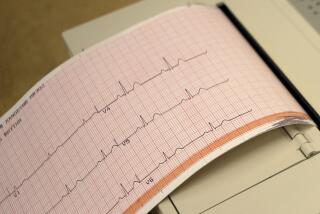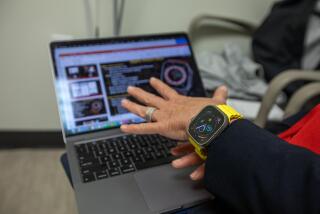Promising Technologies Augur a New Era for Cardiac Medicine
- Share via
It’s a common story: A middle-aged man who has recently received a clean bill of health from a physical exam suddenly drops dead of a heart attack.
Despite great strides in diagnosing heart disease and treating it with a wide range of increasingly sophisticated technologies, doctors still fall short of accurately predicting which patients are at greatest risk of suffering a heart attack. The problem is that it remains difficult to precisely assess the condition of a patient’s coronary arteries using current technologies. And most techniques used to explore this question are expensive, invasive, time-consuming, imprecise or sometimes risky.
“Right now, most of our strategy centers around waiting for a heart attack to occur, hoping that the patient survives,” says Sidney C. Smith Jr., past president of the American Heart Assn. and director of the Cardiovascular Center at the University of North Carolina in Chapel Hill. “But more than 250,000 don’t each year.”
At least a third of those who suffer heart attacks never have earlier episodes of chest pain that would alert them to a problem, according to a recent study published in the Journal of the American Medical Assn. And while many have the usual risk factors--high blood cholesterol, diabetes, high blood pressure, obesity, smoking, family history of heart disease--so do a lot of people who never have heart attacks. What’s missing is a test that can more accurately predict who is likely to have a heart attack or other cardiac event.
For this reason, researchers are aggressively developing a number of noninvasive tests such as magnetic resonance imaging, ultra-fast CT scans and contrast echocardiograms that can allow them to look inside the hearts of high-risk but asymptomatic patients in bold new ways and better assess risk.
“These are the technologies that are going to have a major impact on how clinical decisions are made in the cardiovascular arena over the next few years,” says Robert Balaban, scientific director of the Laboratory Research Program and chief of the Laboratory of Cardiac Energetics at the National Heart, Lung and Blood Institute.
Although still in the research and development phase, the new imaging techniques can already detect unsuspected heart damage, closely examine artery walls and identify the composition of atherosclerotic plaque--the accumulation of fatty material laced with collagen--all of which may help in assessing a patient’s risk. The price of these screenings is declining, making them more accessible and likely to be used once they are widely available. Plus, they have the advantage of being noninvasive--and therefore less risky.
The Potential of MRI
With the publication last week in the journal Circulation of the first successful, high-resolution MRI images of coronary artery plaques in humans, scientists moved a step closer to making these new technologies a reality.
Magnetic resonance imaging is a painless, noninvasive technique that uses a highly uniform magnetic field to provide crystal-clear pictures of static body parts, from the brain to the knee. But the constant beating of the heart and blood flow in the coronary arteries have been hurdles to using MRI in real time for cardiac purposes.
Now, researchers at Mount Sinai Medical Center in New York report that they can “black out” blood flow in coronary arteries well enough to accurately visualize blockages and the coronary wall itself. The advance offers the potential to one day use MRI to avoid angiography or even replace it with noninvasive MRI.
Angiography is currently the gold standard for looking inside arteries, and it is used to diagnose and remove blockages via balloon angioplasty or to place stents that keep coronary arteries propped open. But it’s an invasive procedure that carries its own risk. Angiography involves making a tiny incision in the femoral artery in the groin, then threading a catheter up the artery into the heart to inject dye.
While the dye is injected, an X-ray image of the heart projected on a monitor reveals the locations and approximate sizes of blockages. Although it can yield essential diagnostic information, angiography misses up to 70% of problems, according to a 1994 Scandinavian study, because it looks at the inside of arteries but can’t reliably scan artery walls.
For this reason, the latest MRI findings promise “a much-needed, noninvasive method to identify ‘vulnerable’ plaques--those most likely to lead to sudden clot formation and an acute heart attack,” says Claude Lenfant, director of the heart, lung and blood institute, which funded the study. “The new MRI technique may become an important tool to help physicians identify those individuals who are most likely to suffer a heart attack.”
Even as these new technologies move toward the center stage of cardiology, they will not replace all the screening tests used today. Doctors will still rely on family medical history to identify high-risk patients. And the usual screening tests, from monitoring blood pressure and cholesterol levels to measuring blood sugar for evidence of diabetes, will still play a role. Only then, after these tests identify the high-risk folks, are the new imaging techniques likely to be used.
“Angiography is not going to die away,” says Zahi Adel Fayad, director of cardiovascular imaging, physics and research at Mount Sinai’s Zena and Michael A. Wiener Cardiovascular Institute. “It will be used not only for diagnosis, but for intervention. But I think that one day we will triage with MRI or one of these other technologies first. Then some patients will get medical therapy and some will get interventional treatment such as angioplasty or bypass surgery.”
Others, including Julio Panza, head of the national institute’s echocardiography section, caution that the procedures will have to be used wisely so as not to either fuel already-soaring medical costs or result in unnecessary invasive testing. “Even if it is a perfect test, you still have to ask, ‘Is it worth doing in a large population?’ ” Panza says.
Many researchers think it will be. By coupling these emerging technologies with standard blood tests and new, more-accurate blood tests, doctors believe they soon will be able to take the guesswork out of determining who is most likely to have a heart attack or stroke. And then, Smith says, “we can begin to identify a population that would benefit from very aggressive preventive strategies.”
A More Nuanced Picture
For years, cardiologists believed that the bigger the blockage obstructing a coronary artery, the greater the risk of suffering a heart attack or stroke.
Blockages that filled less than 50% of an artery were monitored, but often not treated, because they did not hamper blood flow.
But the latest evidence suggests that up to two-thirds of heart attacks are caused by blockages that fill less than half of an artery’s diameter. That makes relying solely on the size of the blockage to determine the course of treatment “a little bit like looking at the hole in the center of the doughnut and trying to decide what the doughnut will taste like,” Smith said. “What we have learned over the last 10 years is that one cannot judge by the severity of the obstruction what the future holds for the patient.”
The challenge is to identify dangerous plaque and treat it before damage occurs. That’s where the new technologies come in.
Blockages made of mature atherosclerotic plaque, anchored by collagen, appear least apt to cause a cardiac problem. So-called vulnerable plaque, which contains a soft, fatty center, seems to be particularly fragile and likely to burst and cause an obstruction that produces a heart attack or stroke.
“There’s no doubt that we have made a lot of advances against coronary artery disease,” said Michael Pentecost, chairman of radiology at Georgetown University Medical School. “But in an aging population, this will be a common disease. Being able to image the heart and the arteries without (the patient’s) having to be in the hospital overnight would be a tremendous advantage.”






